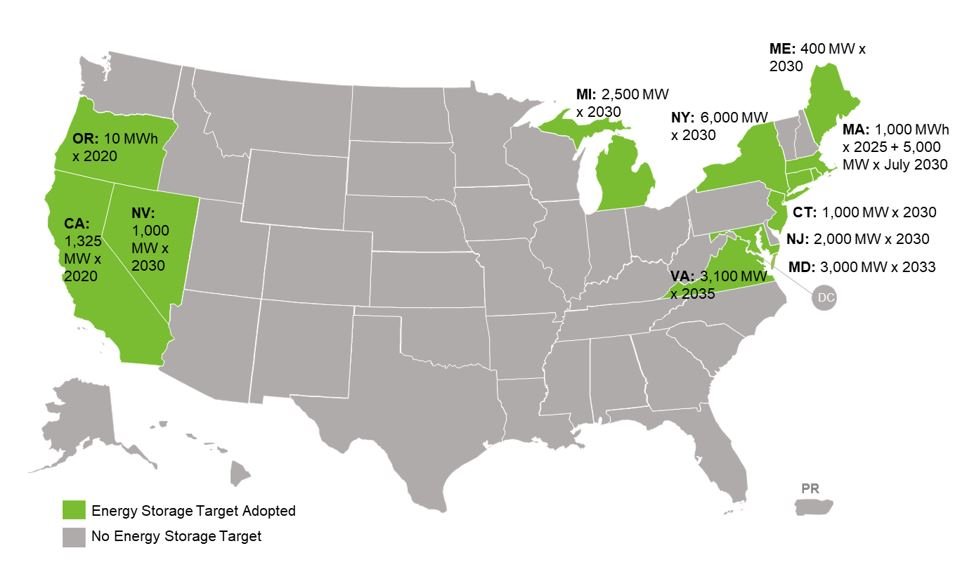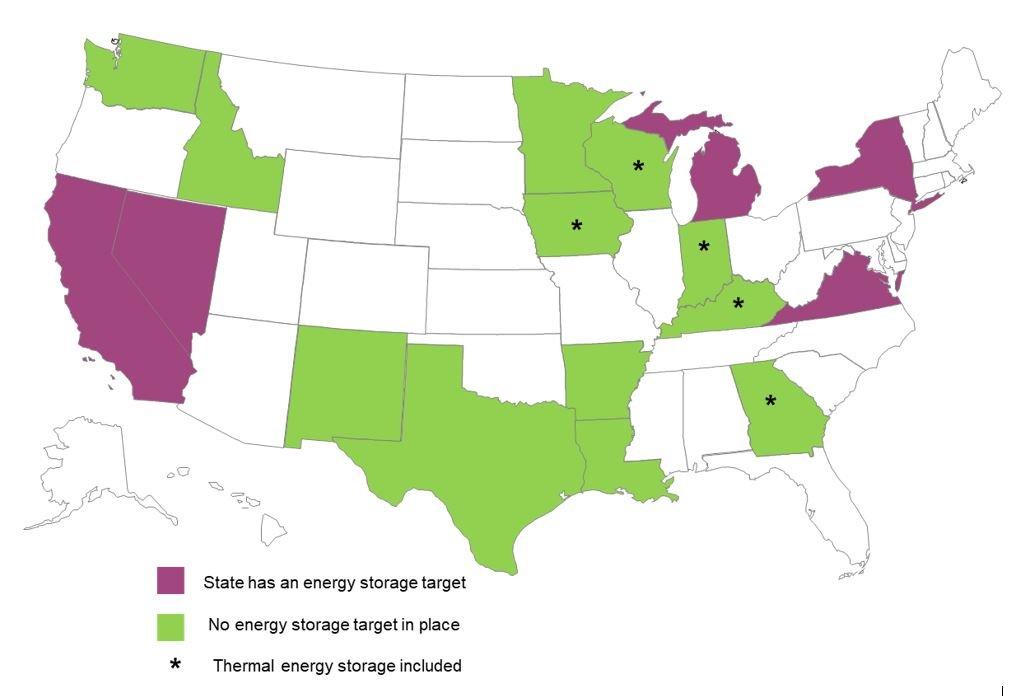By: Vincent Potter, Project Manager
Energy storage has been a hot topic and growth sector in the sustainable energy space for years. Utilities, regulators, and customers see value in various types of energy storage such as electrochemical storage in batteries, thermal storage in ice or water, or mechanical storage designs. Consumers, utilities, and policymakers also consider storage "duration" or how long an energy storage system can continuously output its rated power. As of February 2025, twelve states have energy storage targets, the largest of which is New York with a goal of 6,000 MW by 2030.
In mid-2024, lawmakers in Rhode Island established a 600 MW energy storage goal to be achieved by 2033. In Massachusetts, the Governor signed a bill establishing new energy storage requirements in late 2024. The bill, S.B. 2967, adds language to statutes requiring that all utilities jointly solicit proposals for up to 5,000 MW of energy storage capacity. The statute would require storage of varying durations to be contracted by July 31, 2030; 3,500 MW of mid-duration energy storage, 750 MW of long-duration storage, and 750 MW of multi-day energy storage. In this law, Massachusetts defines storage durations; short-duration is 2 to 4 hours of continuous output. Mid-duration is defined as 4 to 10 hours, long-duration is 10 to 24 hours, and multi-day storage must be capable of dispatching a system's full rated output for longer than 24 hours.
State Energy Storage Targets (February 2025)
Several state legislatures proposed actions to create new or amend existing energy storage targets in the last year. A bill codifying the New Jersey Energy Master Plan is pending in the State Senate. The bill would set the goal of 2,000 MW of energy storage capacity capable of discharging for at least 24 hours active within the state by 2035. Lawmakers in Illinois introduced several bills in mid-2024 which included energy storage procurement targets. One pair of bills targets 7,500 MW by 2030, and a separate set of bills would set the goal at 9,000 MW by 2030 and 15,000 MW by 2038. Legislators in New York introduced bills to double the state storage targets, increasing from 3 GW to 6 GW, but those bills did not advance during the legislative session. However, the New York Public Service Commission issued an order adopting an energy storage roadmap for the state and setting the 6 GW goal.
Utilities frequently propose new storage deployments, even in states and regions where legislative mandates are not in place, noting that the services that energy storage can provide such as load or frequency balancing or providing peaking capacity. Idaho Power and Public Service Company of New Mexico factor dispatchable balancing assets, like energy storage, as part of their capacity procurement plans. As coal plants and other large generators become uneconomical and retire, balancing services from energy storage will become more important to maintain reliability of the electric grid.
As of February 2025, utilities had active or pending procurements for energy storage assets operating in states without energy storage mandates. If all of the RFPs, applications, and other utility proposals that were active at the end of 2024 are filled, utilities will add over 18.5 GW of energy storage capacity in places including Arkansas, Louisiana, Georgia, Iowa, Indiana, Puerto Rico, Texas, Washington, and Wisconsin. Interestingly, there seems to be robust participation in many storage solicitations, irrespective of geography. According to a statement from the utility, Puget Sound Energy's recent request for proposals sought 29 MW of storage but received proposals for a total of 229 MW.
Noteworthy Recent Energy Storage Procurement Activity
Recently, several proposals have sought to use thermal energy storage to offset peak demands. Utilities in Georgia, Kentucky, Indiana, Iowa, and Wisconsin have either opened requests for proposals or petitioned for regulatory approval of energy storage, which includes thermal energy as well as electrical. Thermal storage can offset energy use for heating or cooling by directly storing that energy type that will be needed at some point in the future. For example, chilled water storage can run electric water chillers overnight, when power is less expensive, and distribute that chilled water for cooling during a hot afternoon to avoid more expensive power purchases.
Interested in more information about current energy storage-related actions? DSIRE Insight offers quarterly and annual reports regarding energy storage rules and deployment in the 50 States of Grid Modernization Report, and energy storage targets, procurement, and resource plan notes in the 50 States of Power Decarbonization Report. See our Publications and Subscriptions for more information.


